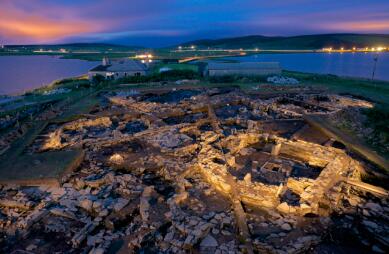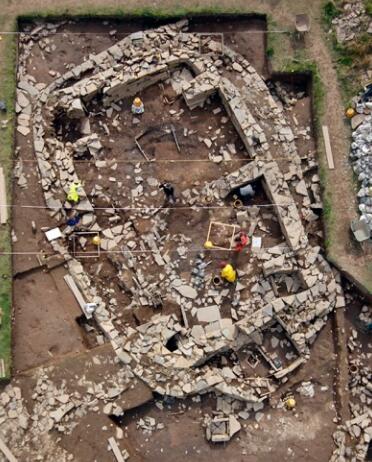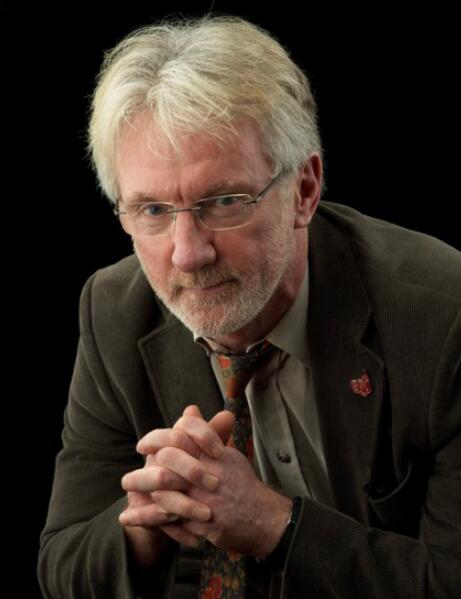2019 SAF Discovery Awards|The Ness of Brodgar, Orkney, Scotland
The Ness of Brodgar (http://www.nessofbrodgar.co.uk) is a unique, Neolithic complex in the Heart of Neolithic Orkney World Heritage Site (WHS). It is situated on the Orkney Islands off the northern tip of Scotland, on a thin isthmus at the centre of one of the richest archaeological landscapes in northern Europe. It lies midway between the stone circles of the Ring of Brodgar and the Stones of Stenness, with Maeshowe, possibly the finest Neolithic chambered tomb in Europe visible in the near distance.
The site was only discovered in 2002 as part of a major geophysical programme intended to put the monuments of the newly designated World Heritage Site into their wider context. This revealed a dense concentration of anomalies covering the two fields at the Ness. The complexity of the results meant that excavation would be required to aid their interpretation. The following year the chance discovery of a large notched slab during ploughing acted as a catalyst for ground-truthing the results. Initial trenching around the find spot revealed a very angular and symmetrical corner buttress within a building, which was remarkably similar in style to one structure discovered at the nearby Neolithic village of Barnhouse excavated in the 1980s.
To further clarify the nature of the geophysics and assess the potential of further agricultural damage, several seasons of trial trenching followed. It soon became apparent that the large whaleback ridge of the isthmus (circa 2.5 hectares in area and rising to circa 5m high), till then considered to be a natural feature in the landscape, was mainly the result of human activity – a large tell-like mound representing many generations of Neolithic activity. Since then there have been annual, large-scale area excavations (but still covering less than 10% of the overall site), managed by the University of the Highlands and Islands Archaeology Institute and the Ness of Brodgar Trust. This has revealed a deeply stratified, multi-phase complex spanning the whole of the Neolithic period of northern Britain circa 3500- 2400calBC, but with indications of both earlier Mesolithic and later Iron Age activity. The sequence of structures reflects changing styles of architecture seen elsewhere in the domestic sphere, from early oval buildings with orthostatic divisions, followed by houses with bed recesses built into walls, and latterly houses with beds projecting into the floor area. But the Ness buildings are also different in that they are of an exaggerated form, both in their scale and complexity of design.

In the main phases (circa 3,200 – 2,400 calBC) presently under investigation the Ness was dominated by many large, freestanding buildings partly enclosed by massive stone walls. Most of the buildings presently uncovered share a common architecture, of opposed stone piers defining internal space, but beyond this basic shared feature they are of a large range of size and finesse of build. These differences may imply the work of different communities, each wishing to have a presence at the Ness, and reflecting competition between these groups.
Overall the preservation is outstanding with walls surviving to over a metre in height, which clearly show the mastery of the Neolithic masons in their understanding of their raw material and its selection. Although much of the stone comes from local quarries, some of the coloured sandstone has been extracted from locations many kilometres away. Not only did these structures appear special internally with their angular, symmetrical architecture, but also externally for their roofs were covered in regular stone slates – a technique still used in Orkney today. The quality of preservation also allows accurate biographies of each building to be constructed, as they were remodelled, altered and their function changed.
Although on first appearance the buildings seem almost randomly laid out, there is a certain order to their organisation. Some are arranged around a central paved area with a north-south aligned standing stone, while others are located with reference to other standing stones on the site and in some instances aligned on cardinal points of the compass. A level of planning is also implied by the drainage system that underlies and surrounds most of the buildings and feeds into a large central drain.
It is no revelation that the Neolithic in North-Western Europe (and elsewhere) saw societies gather, cohere and turn around important monuments. We also know that individual monuments were often sustained or referenced over time, repeated gatherings marked by a legacy of monument complexes. So, it is with the World Heritage Area in Orkney, long recognized for the remarkable concentration of tombs and other places of public ceremony. What makes the Ness so important is that it offers us a chance to understand what went on at the hub of this landscape. The entire ‘bowl’ of the Brodgar peninsula and surrounding land turns on the area occupied by the Ness. It seems to have been pivotal to the events witnessed at monuments like the Stones of Stenness, Maeshowe or the Ring of Brodgar. And from the exceptional deposits that survive, it also had a significance of its own, as a place that was important and socially pivotal for the Neolithic communities scattered around the Orkney archipelago and (most likely) even further afield.
The full nature and history of the complex is not yet fully established although dating programmes indicate over 1200 years of episodic activity. However, it is already clear that the structural/architectural character of the Ness of Brodgar sets it apart from other places across the region. Those visiting the immediate area in the Neolithic would have recognized the ways that most of the buildings on the Ness were put together; their own homes were the result of similar choices. What they would not have been familiar with was the scale of the structures; the truly monumental nature of individual buildings and enclosing walls. They would have also been confronted by a dramatic sense of time depth in the complex. To this we can add the evidence of extensive artefact and bone assemblages, coloured pottery, exotic material from across Britain (including pitchstone, an obsidian like material from south-west Scotland, axe blanks from the axe factories of the Lake District of northern England, and ceramic styles most closely paralleled in the Stonehenge area); the interior fabric of the many buildings; the selective use of coloured building stone; painting with pigments and a rich corpus of over 850 examples of Neolithic art (more than the rest of the UK in its entirety). The art in particular is truly remarkable because much survives in context, which is very rare in such monument complexes. Much of the art is only paralleled by examples from Ireland, again reiterating the wide network of contacts the Ness had across the British Isles.

All this implies that this was no domestic settlement. During its main phases it seems it was a place for the coming together of people from across Orkney and beyond, where they took part in exchange, feasting, conspicuous consumption, in celebrations of the important events, central to this vibrant society.
The high level of activity is also reflected in the largest Neolithic midden mound in the UK, over 70m in diameter and presently over 4m high, at the very tip of the peninsula just outside the walled enclosure. This is comprised mainly of ash and midden intermingled with cultural material. The scale of the mound seems to make a deliberate statement, reflecting the affluence and status of the site, and as a place of conspicuous consumption: a symbol of the importance of the Ness.
Although the structures encountered in the main trench are extravagant, sealed below this huge midden mound is another structure that combines many unusual features, Structure 27. This is a large sub rectangular building that, although badly robbed of stone, is not only exquisitely finished externally but also internally, where it was clad in orthostats partly supported by prone orthostats up to 4.55m long. Presently this building is unique. Floor levels have yet to be revealed but it may be the Orcadian equivalent of a large Neolithic timber hall, translated into stone. The accomplished nature and refinement of the stonework has much in common with the final major building on site, Structure 10.
Although most of the earlier period buildings remained in use, Structure 10 (built circa 2950cal BC) was a marked departure from these in terms of its scale (overall circa 19m wide by 20+m long), layout architecture, and presumed social organisation. Although sharing similarities with the later style of Neolithic house as at Skara Brae, in every respect Structure 10 displays the monumentalisation of the domestic or what has been referred to in the UK as a ‘big house’. A similar trajectory is seen at the nearby Barnhouse village with the construction of building number 8, the closest parallel for Structure 10 at the Ness.
In its primary form it had a sub-square chamber with rounded corners defined by monumental walls up to 4.5 m thick, that internally utilised many pick-dressed slabs of sandstone of different colours. It incorporated several standing stones in its build, had a surrounding paved pathway, and a forecourt area and entrance aligned with Maeshowe and the equinox sunrise.
Like the other late buildings on site, Structure 10 suffered from subsidence (due to underlying earlier buildings) – its south-western corner collapsed within a generation or two of its initial construction (or was it by intentional demolition?), but the structure was rebuilt and extensively remodelled (circa 2850 cal BC). Its central chamber became cruciform in plan with the addition of corner buttresses, under which special votive foundations were found including a carved stone ball, a substantial, richly decorated stone and a human arm bone. These buttresses might be viewed as merely a structural necessity to counter further instability but can also be seen as reflecting in stone the four post settings found in some large late Neolithic buildings outside of Orkney, and indeed in the central chamber of Maeshowe. At the Ness this remodelling of Structure 10 coincides with a change of function of the surviving earlier period buildings, with most of them being remodelled and some becoming more utilitarian or semi-industrial in nature. As with earlier changes in architectural style, the implication is another major social change.
The final demise of the Ness occurs in the latter part of the third millennium. Structure 10 is partially demolished and the interior infilled to create a cairn like mound. The remains of other buildings are infilled with midden and obliterated from view. A final act, before systematic stone robbing, is the deposition of the remains of at least 400 cattle around Structure 10. Was this an act of commemoration or the celebration of a new order? This event roughly coincides with the apparent more widespread collapse in Orkney of previous networks evidenced by the rare occurrence of Early Bronze Age Beaker ceramics. The discovery of a single sherd of Beaker pottery and a classic early Bronze Age barbed and tanged flint arrowhead in layers just above the cattle bone deposit is an intriguing clue as to the endgame of the Ness. Whatever the Ness had represented through its various incarnations over the previous millennium this was being eclipsed.
All of these factors make the Ness of Brodgar a place where we can expect to uncover more evidence that transforms our picture of social life and social change in the Neolithic. It can contrast with recent work at Durrington Walls and Stonehenge, with the demonstrated potential to reveal the specific material and historical conditions in which people constructed their worlds in and around the Northern Isles. It can be compared with other sequences across Atlantic Europe, adding to our understanding of how things unfolded in this region, and reveal much about the nature of contact and communication at broader scales.
The Ness of Brodgar excavations are primarily a research project which fulfils themes in the WHS Research Agenda, the Scottish ScARF report, UNESCO’s conditions, and the WHS Management Plan, but the Ness also actively pursues a high level of community and public engagement. Volunteers are encouraged to participate both in the excavation and post-excavation processing. The public are invited to visit the excavations and attend our free guided tours and special open days and view the site from an elevated platform and take advantage of the numerous interpretation panels. Specialist and school groups are catered for. The excavation can be followed virtually through our daily online illustrated diary and social media. These have attracted several million hits. Students and volunteers from around the world attend our field-school, while school children can join our ‘Excavation Club’. Dissemination of the results of the excavation is through many different media including television, radio, WWW, printed articles and features and is tailored to suit all levels of interest, both academic and popularist.

As a research project the incorporation of as wide an array of new and innovative techniques during both excavation and post excavation is being implemented. This includes photogrammetry, archaeomagnetic dating, portable XRF analysis of floors, drone based multispectral survey and photography, laser scanning, GIS, 3-D modelling, residue analysis, micromorphology, RTI photography, refined geophysical survey using a range of techniques, and Smartfauna (a technique that allows the highly accurate 3D spatial analysis of any patterning in complex bone deposits using laser scanning, photogrammetry). These are all paying huge dividends in the production of an overall synthesis of the Ness.
The high profile and exposure the Ness has secured also contributes hugely to the local Orcadian economy. This is not simply through the funds raised to run the excavation (mainly by world-wide donations to the two charities established to support the project), but also via tourism which is the second largest sector of the economy of Orkney after farming. As the Ness of Brodgar has become known world-wide, archaeology has become the number one reason for tourists coming to Orkney – this has been called the ‘Ness Effect.’

Biographic Sketch
Nick has worked widely throughout Britain since graduating from Glasgow University. Over the last two decades he has directed and managed a wide range of projects for the Orkney Research Centre for Archaeology within the University of Highlands and Islands Institute of Archaeology that he assisted in establishing.
He has been an Honorary Research Fellow of the UHI; a Member of Orkney World Heritage Site Research Committee; a Member of the Chartered Institute for Archaeologists; a Fellow of the Society of Antiquarians of Scotland; Chair of the Ness of Brodgar Trust: and Vice president of the American Friends of the Ness of Brodgar.
Since the inscription of Orkney’s World Heritage Site, he has been involved in research and fieldwork relating to the sites: as director of the excavations at Bookan Chambered Tomb; as co-ordinator of the WHS geophysics programme; and as a major contributor to the Research Agenda. His interests lie in all aspects of the prehistory of Britain and the Highlands and Islands with particular reference to the Neolithic.
Since 2004 Nick has directed work at Ness of Brodgar that has become internationally recognised, reported widely including the cover article in National Geographic, and the recipient of several awards, including recognition by the American Institute of Archaeology; the Current Archaeology Research Project of the Year; and the international Andante Travel Archaeology Award.
He has lectured widely in the UK and abroad. In 2017 he was awarded the Kress Travelling Lectureship by the Archaeological Institute of America lecturing across the USA.

